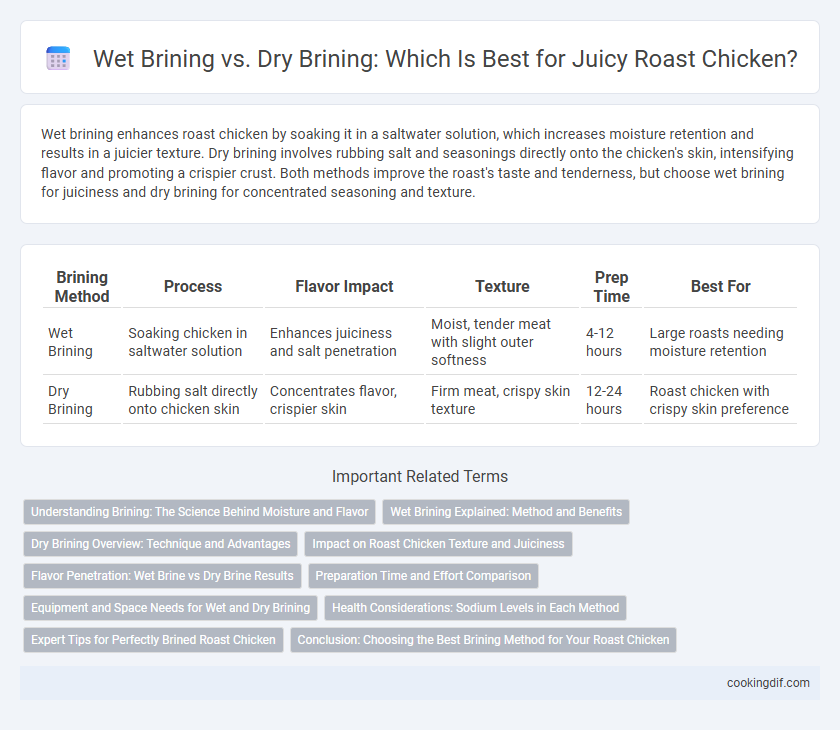Wet brining enhances roast chicken by soaking it in a saltwater solution, which increases moisture retention and results in a juicier texture. Dry brining involves rubbing salt and seasonings directly onto the chicken's skin, intensifying flavor and promoting a crispier crust. Both methods improve the roast's taste and tenderness, but choose wet brining for juiciness and dry brining for concentrated seasoning and texture.
Table of Comparison
| Brining Method | Process | Flavor Impact | Texture | Prep Time | Best For |
|---|---|---|---|---|---|
| Wet Brining | Soaking chicken in saltwater solution | Enhances juiciness and salt penetration | Moist, tender meat with slight outer softness | 4-12 hours | Large roasts needing moisture retention |
| Dry Brining | Rubbing salt directly onto chicken skin | Concentrates flavor, crispier skin | Firm meat, crispy skin texture | 12-24 hours | Roast chicken with crispy skin preference |
Understanding Brining: The Science Behind Moisture and Flavor
Wet brining infuses roast chicken with a salted water solution that enhances moisture retention by increasing the meat's water content through osmosis and protein denaturation. Dry brining uses salt directly on the chicken's surface, drawing out moisture that reabsorbs with concentrated flavors, improving texture and taste without added water. Both methods optimize juiciness and flavor by altering the muscle proteins' ability to trap moisture during cooking.
Wet Brining Explained: Method and Benefits
Wet brining involves soaking the roast chicken in a saltwater solution, which enhances moisture retention and juiciness during cooking. The salt in the brine penetrates the meat, breaking down muscle proteins and allowing the chicken to absorb and retain more water. This method results in a tender, flavorful roast with a moist texture and improved seasoning throughout.
Dry Brining Overview: Technique and Advantages
Dry brining involves seasoning the roast chicken with salt and allowing it to rest uncovered in the refrigerator for several hours or overnight, which enhances moisture retention and intensifies flavor. This technique improves skin crispiness by drawing out surface moisture while ensuring the meat remains juicy and tender through gradual salt absorption. Compared to wet brining, dry brining reduces prep time and mess, making it a convenient method that preserves the natural texture and depth of the roast chicken.
Impact on Roast Chicken Texture and Juiciness
Wet brining a roast chicken involves soaking it in a saltwater solution, which increases moisture retention and results in a juicier, tender texture by allowing the meat to absorb and retain water during cooking. Dry brining, by applying salt directly to the chicken's surface, enhances skin crispiness and concentrates flavors while also improving texture through protein breakdown and moisture retention. Both methods effectively boost juiciness, but wet brining yields a more uniformly moist interior, whereas dry brining emphasizes a balance of crispy skin and juicy meat.
Flavor Penetration: Wet Brine vs Dry Brine Results
Wet brining a roast chicken involves soaking it in a saltwater solution, which enhances moisture retention and results in juicier meat with moderate flavor penetration. Dry brining, where salt and seasonings are rubbed directly onto the skin and meat, allows for deeper, more intense flavor absorption due to the salt drawing out and then reabsorbing the chicken's juices. Studies and culinary tests show dry brining yields a more concentrated, savory taste profile, while wet brining produces a milder, more evenly salted flavor throughout the roast.
Preparation Time and Effort Comparison
Wet brining a roast chicken typically requires 8 to 12 hours of soaking in a saltwater solution, demanding more preparation time and space. Dry brining involves rubbing salt directly onto the chicken and resting it for 1 to 2 hours, significantly reducing effort and improving skin crispness. Choosing dry brining optimizes convenience without compromising flavor, ideal for quicker meal preparation.
Equipment and Space Needs for Wet and Dry Brining
Wet brining a roast chicken requires a large container or resealable bag to fully submerge the bird, demanding more fridge space and extra equipment like a thermometer to monitor brine temperature. Dry brining minimizes equipment needs, only requiring a tray or rack to hold the chicken and enough fridge space for airflow around the bird. For small kitchens or tight fridge conditions, dry brining offers a more practical, low-equipment solution while wet brining requires planning for larger space and containers.
Health Considerations: Sodium Levels in Each Method
Wet brining significantly increases sodium content in roast chicken due to the saltwater solution penetrating the meat, which can impact individuals monitoring their sodium intake. Dry brining uses less salt applied directly to the skin and meat surface, resulting in a more controlled sodium absorption and lower overall sodium levels compared to wet brining. Choosing dry brining helps reduce excess sodium consumption while still enhancing flavor and moisture retention in roast chicken.
Expert Tips for Perfectly Brined Roast Chicken
Wet brining involves soaking the roast chicken in a saltwater solution, enhancing moisture retention and seasoning throughout the meat. Dry brining uses kosher salt rubbed directly on the skin and under the breast, intensifying flavor and producing crispier skin by drawing out moisture before roasting. Expert chefs recommend dry brining 24 to 48 hours ahead for optimal texture and flavor, while wet brining suits faster preparation with up to 12 hours soaking for tender, juicy results.
Conclusion: Choosing the Best Brining Method for Your Roast Chicken
Wet brining enhances roast chicken with juicy, flavorful meat by soaking in a saltwater solution, ideal for larger birds or longer cooking times. Dry brining draws moisture from the skin, resulting in crispier, more concentrated flavors with a simpler, less messy process. Choosing the best method depends on desired texture and convenience, with wet brining favoring moisture retention and dry brining optimizing skin crispness and ease.
Wet Brining vs Dry Brining for Roast Chicken Infographic

 cookingdif.com
cookingdif.com